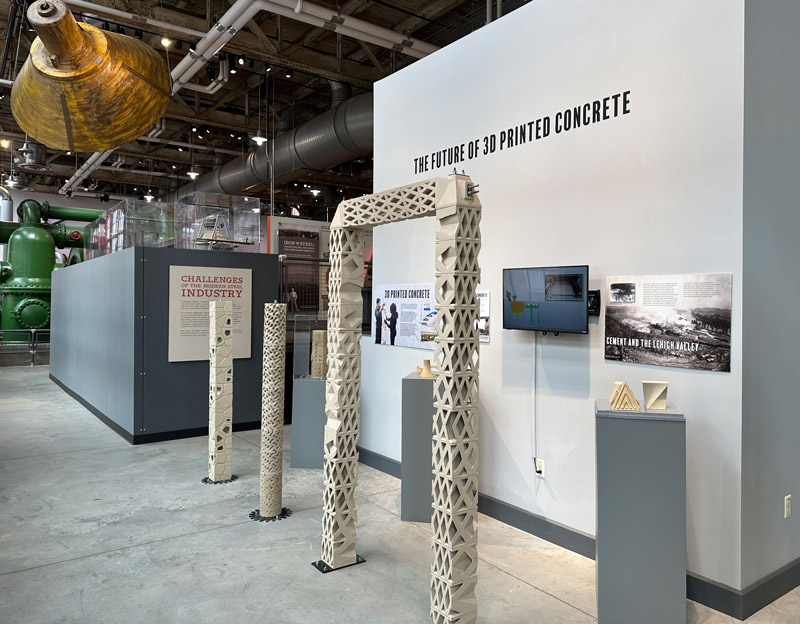Lehigh researchers have developed an innovative method for concrete construction that combines 3D printing and topology optimization, a mathematical method of distributing material in an efficient way for a given design space.
“While using ‘old’ ingredients,” says Paolo Bocchini, a professor of civil and environmental engineering (CEE), “this new manufacturing technology effectively gives us access to a new construction material, 3D printed concrete, which enables the creation of completely new geometrical shapes, exceptional structural efficiency, and superior environmental sustainability.”
 Structural engineering alum Xingjian Wang ’19G ’24 PhD, worked on the technology, called 3D printing by selective binder activation, while a doctoral student under the supervision of Bocchini and fellow CEE faculty members Clay Naito and John Fox. The project team also includes Nik Nikolov, an associate professor of architecture in Lehigh’s College of Arts and Sciences, CEE doctoral student Urinrin Otite, and industry collaborator Buzzi Unicem USA.
Structural engineering alum Xingjian Wang ’19G ’24 PhD, worked on the technology, called 3D printing by selective binder activation, while a doctoral student under the supervision of Bocchini and fellow CEE faculty members Clay Naito and John Fox. The project team also includes Nik Nikolov, an associate professor of architecture in Lehigh’s College of Arts and Sciences, CEE doctoral student Urinrin Otite, and industry collaborator Buzzi Unicem USA.
The approach uses topology optimization to guide the design of structures.
Currently, structures often contain too much material in areas that aren’t responsible for bearing heavy loads, but are just there to simplify construction. For example, rectangular cross-sections, constant throughout the length of a beam, do not use material efficiently. Optimizing the design of such features can ensure materials aren’t wasted, thereby minimizing the cost and environmental impact of construction projects.
3D printing brings those optimized designs to life.
In traditional concrete construction, concrete is poured into a specially designed mold—often made of wood—called formwork. It holds the concrete until it’s cured, but it’s a resource-heavy and labor-intensive part of the construction process.
Together with his colleagues, Wang has helped develop a method that doesn’t require such a mold. And, unlike other 3D-printing techniques currently in use for building large-scale structures (like bridges), their method does not extrude wet concrete paste, says Wang.
Instead, it deposits two materials separately onto a build platform. The first material is a dry powder of cement and fine sand. The second is called binder activator, which is about 95 percent water and serves to activate and hydrate the cement. The aqueous activator is deposited selectively onto a thin layer of dry powder forming the geometry of the structure. As the procedure is repeated, the structure is supported by the surrounding nonactivated powder and no external assistance is necessary.
“Using this technique, we can also print a structure with cavities and overhangs, which you can’t do with typical 3D printing by material extrusion because wet concrete can’t just hang there without support,” he says. “So we could print a wall with openings for windows and doors.”
Designs produced via the technique are currently featured in an exhibit at the National Museum of Industrial History and recently appeared on the cover of Structure magazine, a publication of the National Council of Structural Engineers Associations.
The research was partially supported by the PA Department of Community and Economic Development.
"The 3D printing of concrete is a manufacturing technique that aims at revolutionizing the construction industry,” says Bocchini, “and allows designers to use material only where it is most beneficial, reducing waste, cost, environmental impact, and labor."
Wang is inspired by the potential of the two technologies to reduce the carbon footprint of the construction process—and its potential to drive creativity.
“This method gives you design freedom,” he says. “You can create whatever you can imagine.”

